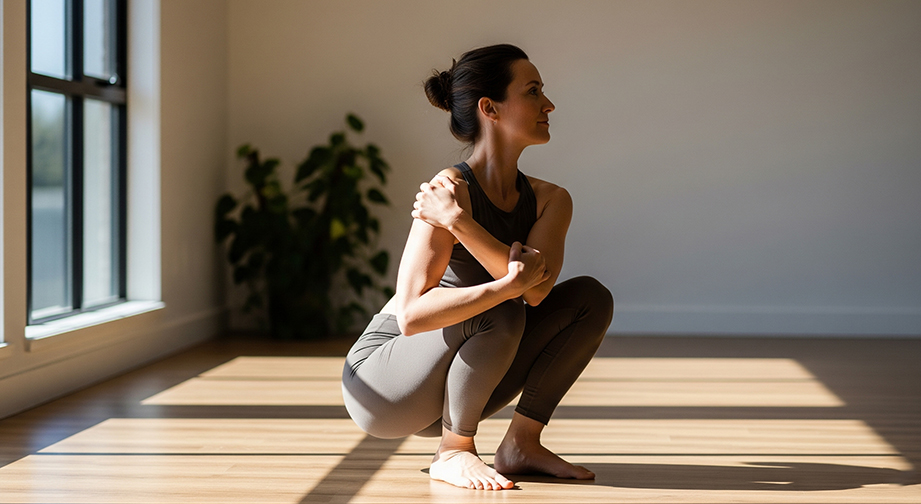Pashasana (Noose Pose) – A Complete Guide to This Twisting Yoga Squat
Introduction
Pashasana, also known as the Noose Pose, is a unique twisted squat in yoga that gently wrings out tension from both the spine and the mind. In Sanskrit, Pasha means "noose" or "tie," reflecting the way your arms loop around your legs in this position. This asana offers a beautiful sense of grounded calmness and detoxification.
If you’ve ever felt stiff after sitting too long or want to unlock tight hips and a sluggish spine, Pashasana could become your new best friend!
Step-by-Step Guide: How to Practice Pashasana (Noose Pose)

- Start in a Squat:
Stand with your feet hip-width apart. Bend your knees and lower your hips into a deep squat (Malasana alignment).
- Modification: If your heels don’t touch the floor, place a folded blanket, block or rolled mat under them for support.
- Twist Your Torso:
Keep your knees together. Inhale and lengthen your spine.
Exhale, gently twist your torso to the right, bringing your left upper arm to the outside of your right knee.
- Loop and Bind:
Reach your left arm forward and around your right shins, as far as comfortable.
Take your right arm behind your back and try to clasp your left wrist or fingers.
Don’t strain! Just reach as far as is accessible to you today.
- Hold and Breathe:
- Stay for 3–6 breaths. Inhale to lengthen the spine, exhale to deepen the twist gently.
- Keep the chest open and shoulders relaxed.
- Release & Repeat Other Side:
- Gently untwist and come to center on an inhale.
- Repeat on the other side.
- Recommended rounds: 1–2 times per side.
Beginner Modifications:
- Loop a yoga strap or belt around your shins and hold it with both hands if you can’t clasp your wrists.
- Keep your heels supported on props.
- Don’t force the bind; focus on the twist and breath first.
Advanced Variations:
- Deepen the squat with heels on the ground and a full wrist clasp.
- Try a tighter twist, or extend the bind/fingers more fully.
- Attempt the pose with feet together for extra intensity.
Alignment & Safety Tips
- Keep your knees together for a stable base and deeper twist.
- Lengthen the spine as you inhale, twisting from the waist rather than yanking your shoulders.
- Don’t collapse forward; keep the heart lifted and gaze soft.
- Feet flat is ideal, but use props if your heels lift.
- Common mistakes:
- Letting knees splay apart – keep them together or use a block between thighs.
- Forcing the bind – focus on the twist, not the hand clasp.
- Safety Precautions:
- Avoid if you have knee or ankle injuries.
- Pregnancy: Avoid strong twisting poses after the first trimester.
- Back or digestive issues: Practice gently or skip if uncomfortable.
Benefits of Pashasana (Noose Pose)
Physical Benefits
- Increases flexibility in spine, ankles, and wrists.
- Strengthens legs, core, and back muscles.
- Improves posture and detoxifies internal organs (gentle abdominal massage).
- Stimulates digestion by compressing the abdomen.
- Opens chest and shoulders.
Mental Benefits
- Promotes mental calmness and focus.
- Relieves stress, especially when paired with mindful breathing.
- Encourages a sense of grounding and release.
Energy/Chakra Connection
- Connects to the Manipura Chakra (solar plexus) for self-confidence and transformation.
- Helps balance internal energies through twisting and releasing tension.
Contraindications
- Avoid if pregnant (strong twists compress the belly).
- Skip or modify if you have recent or severe knee, ankle, back, or shoulder injuries.
- People with hernias, recent abdominal surgery, or digestive tract issues should consult a doctor.
- Safe Alternatives: Try simple Malasana (yoga squat) or Ardha Matsyendrasana (seated spinal twist).
Beginner’s Tips & Variations
- Props: Place a block or folded blanket under your heels for balance.
- Strap: Use a yoga strap to bridge the gap if hands can’t meet.
- Wall: Practice squatting with the support of a wall behind you for stability.
- Gentle variation: Keep hands in prayer at chest (Anjali Mudra) instead of binding.
- Advanced: Deepen the twist, bind tighter, or practice with feet together.
How to Include Pashasana in a Yoga Flow
- Best as a main practice or deep hip/spine warm-up.
- Pairs well with:
- Malasana (Garland Pose/Squat) – a great way to soften into the squat first
- Ardha Matsyendrasana (Half Lord of the Fishes Pose)
- Parivrtta Utkatasana (Revolved Chair Pose) – for twisting progression
Mind–Body Connection
As you practice Pashasana, focus on each breath and the gentle spiral of your spine. Letting go of unnecessary tension, this pose can symbolically help us “untie” knots of stress or worry. Energetically, it supports transformation, confidence, and inner clarity through purification—an ideal opportunity for mindfulness and self-awareness.
Chakra significance: Activates Manipura (solar plexus) chakra, supporting personal power and self-healing.
Summary Box
- Asana Name: Pashasana (Noose Pose) / ??????
- Level: Intermediate (can be modified for beginners)
- Focus Areas: Spine, hips, ankles, core, shoulders
- Duration: Hold for 3–6 breaths per side, repeat 1–2 rounds
- Best Time to Practice: Morning or evening, on an empty stomach
Frequently Asked Questions (FAQs)
- Is Pashasana safe for beginners?
- Yes, with props and modifications. Start slowly, and use a strap or block if needed!
- Can Pashasana help digestion?
- Yes, the gentle abdominal compression can stimulate digestion and relieve bloating or sluggishness.
- What should I do if my heels don’t touch the ground?
- Place a folded blanket or yoga block under your heels for comfort and support. Flexibility will improve with practice.
Remember: Every body is different! Honor where you are now, and let Pashasana be a journey of gentle unraveling—one breath at a time.